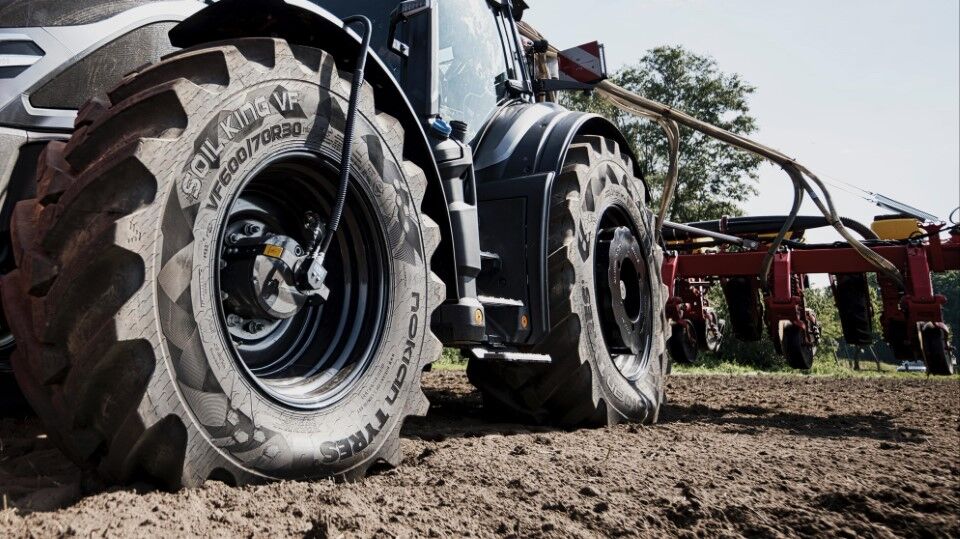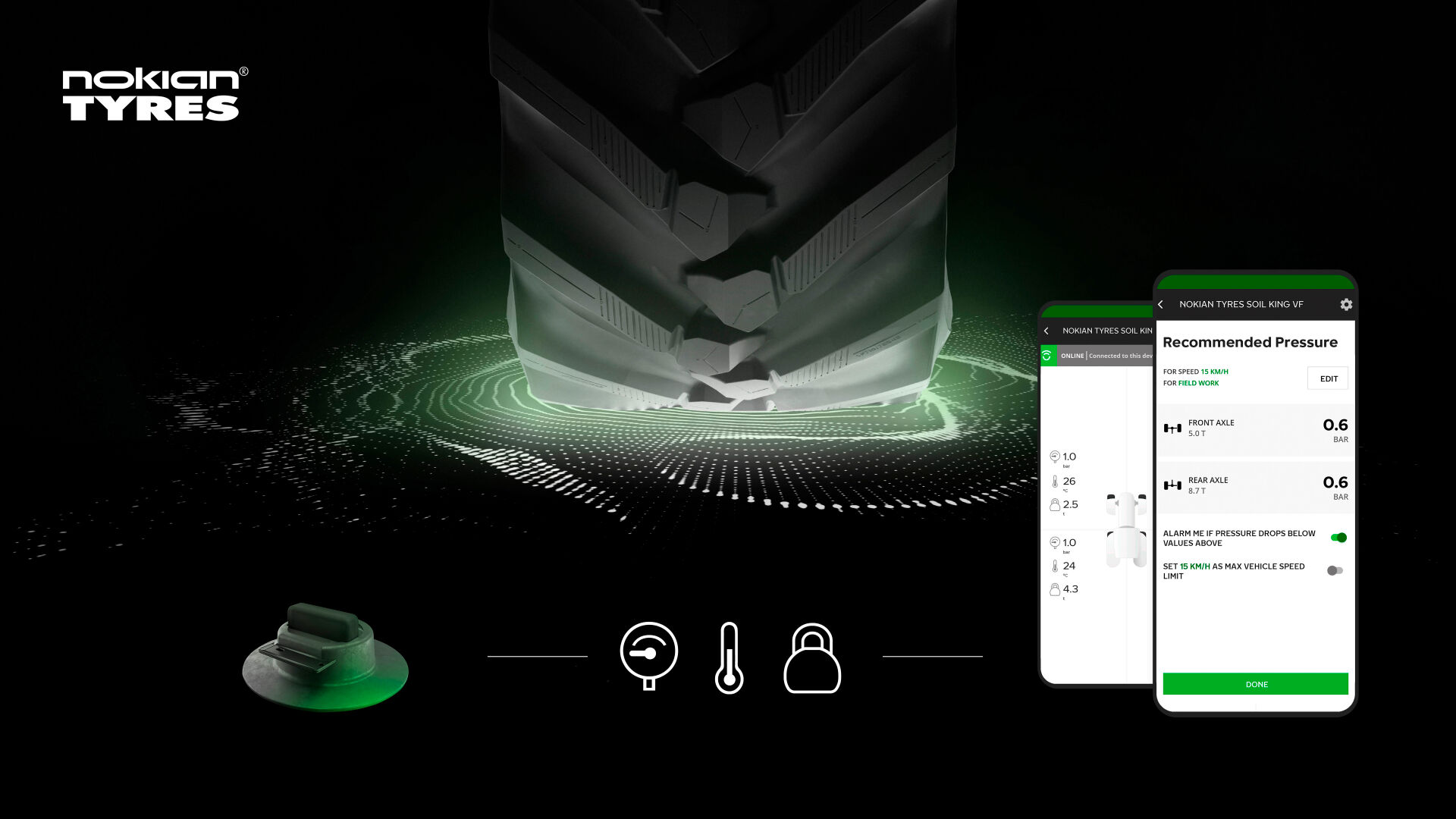Choosing tires
What is tire rolling resistance? Importance of rolling resistance for heavy vehicles

Discussions around tire rolling resistance often focus on passenger cars, but the significance of rolling resistance grows with the machine. A heavy tire can waste considerably more energy than a lighter one, directly affecting operational efficiency and profitability.
This article highlights the importance of rolling resistance for heavy-wheeled machines, with tractor tires serving as a primary example. Tractors frequently switch between different implements, causing the machine's total weight to fluctuate. This constant change directly impacts the efficiency of power delivery to the ground, with tire rolling resistance being a central factor in overall machine operations.

What is rolling resistance on a tire?
Tire rolling resistance is the energy your vehicle must use to keep a tire rolling at a constant speed. As a tire rolls under the weight of a machine, it deforms where it meets the surface, and then returns to its original shape. This continuous cycle of deformation and recovery consumes energy, which is lost as heat. The lower the rolling resistance, the less energy is wasted.
Why does rolling resistance matter?
Paying close attention to the tire rolling resistance of heavy vehicles is important, as it offers significant benefits across your entire operation.
Cost savings
Choosing an energy-efficient tire is an investment that pays for itself with every hour of use. Minimizing the energy wasted by a machine through rolling resistance can directly reduce fuel consumption.
You can save up to €10,000 by reducing rolling resistance and fuel consumption over the lifespan of a heavy tire.
Vehicle performance
The choice of tires and their rolling resistance can significantly improve a tractor's overall energy efficiency. This isn't just a theory; it has been proven by independent testing.
The DLG PowerMix tests simulate a variety of real-world tractor tasks, ranging from heavy fieldwork to road transport, to demonstrate that tires make a significant difference to a tractor's performance. Nokian Tyres Soil King has performed exceptionally well in these DLG PowerMix tests, demonstrating superior efficiency and low rolling resistance.
Fuel efficiency and environmental impact
Selecting tires designed to minimize energy loss allows for less fuel consumption to accomplish the same amount of work.
Reduced rolling resistance can lower fuel consumption by several liters per hour of work.
This fuel reduction directly corresponds to a decrease in the machine's emissions, resulting in maximum productivity with reduced waste, lower fuel consumption, and a smaller environmental footprint.
Tire wear
The rolling resistance of a tire changes over its life. As a tire wears down and the tread depth decreases, its rolling resistance lessens. This is an important factor to remember when considering the tire's overall lifecycle performance.
Factors affecting tire rolling resistance
Several key factors determine a tire's rolling resistance, such as:
- Tire pressure. Tire pressure directly affects how much the tire deforms under load. Incorrect tire pressure leads to excessive deformation and wasted energy. If tires are overinflated, the contact patch with the ground becomes too small, preventing the tractor from transferring its power effectively to the ground. Use the tire pressure chart in the Nokian Heavy Tyres technical manual to set the right inflation pressure for the load and task.
- Design and materials. High-quality materials can lower rolling resistance by as much as 10%, sometimes irrespective of the tread pattern. A low rolling resistance design combined with advanced materials yields the best possible result. Nokian Tyre’s design philosophy is to strike a perfect balance between efficiency, power transfer, and extended service life.
- Vehicle load. Just like incorrect tire pressure, an increased vehicle load causes the tire to deform more. As the tread flattens under a heavier load, the tire requires more energy to complete each rotation, thereby increasing rolling resistance.
- Speed. Higher speeds increase the frequency of the tire's deformation cycles. As the tire works harder and warms up, the rubber becomes more elastic, and the deformation process requires less energy. This is why a warm tire is more energy-efficient than a cold one.
Rolling resistance on soft surfaces and fields
Until now, this article has focused on rolling resistance on hard surfaces. However, on soft ground, the dynamic changes. A heavy tire compresses the soft surface, resulting in deformation of the surrounding soil. This leads to soil compaction, which is detrimental to crop yields.
In the field, the goal is for the tire to deform rather than the soil. This requires the lowest possible tire pressure for the load. Lower inflation pressure increases the contact patch, reducing sinkage and rolling resistance.
By achieving the largest possible contact patch to carry the load, the tire sinks less and lowers the rolling resistance.

Monitoring tire pressure and rolling resistance
Nokian Tyres Intuitu™ 2.0 Smart Pressure Assistant is a next-generation smart tire technology that helps farmers set the correct tire pressure through tire sensors. An upgrade to the Nokian Tyres Intuitu tire monitoring system capabilities will be launched in October 2025, featuring new load-sensing that determines the axle load during usage and automatically suggests the correct tire pressure.

Nokian Tyres Intuitu™ 2.0 will help farmers using the Nokian Tyres Soil King VF tire range maximize their machine's performance by extending tire life, reducing rolling resistance and fuel consumption, while also protecting the soil. It is currently very difficult to determine the correct tire pressure, which is why Nokian Tyres Intuitu™ 2.0 will ultimately help farmers use lower tire pressures with confidence to get the most out of their Soil King VF tires.
Reducing tire rolling resistance
Two key actions are important for minimizing tire rolling resistance:
- Selecting high-quality tires designed for reducing rolling resistance
- Maintaining the correct tire pressure
By focusing on proven low rolling resistance tires, ensuring proper inflation for every task, and understanding how surfaces affect performance and fuel economy, you can achieve significant savings and boost your machine's efficiency.
Find durable, low rolling resistance tires from your nearest Nokian Tyres dealer.
Please remember that it is the driver’s responsibility to ensure their tires are safe and suitable for their vehicle and to follow the vehicle’s manufacturer´s guidelines for proper use and maintenance. Consult your closest Nokian Tyres dealer or your vehicle’s manufacturer for specific advice.


